For perfect citrus oil perfume dilutions, you'll want to follow specific concentration levels based on your desired strength. Use 20-40% oils for Parfum Extrait, 10-20% for Eau de Parfum, 5-15% for Eau de Toilette, or 2-4% for Eau de Cologne. When working with citrus oils, maintain safety limits of 2% for lemon and 4% for grapefruit in your final blend. Store your creation in dark glass bottles at 5-30°C. These basic ratios just scratch the surface of crafting your signature citrus scent.
Understanding Citrus Oil Potency in Perfumes
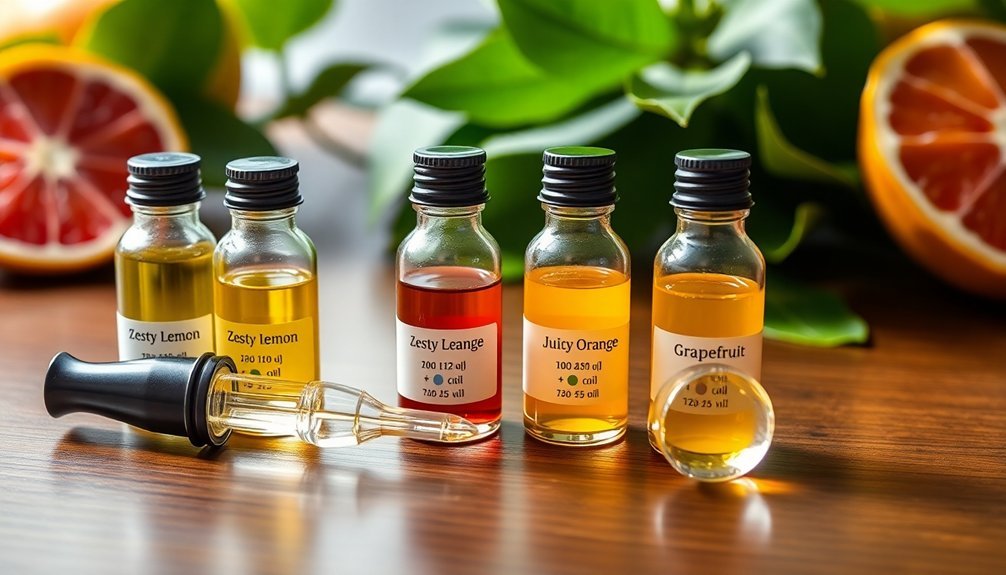
When creating perfumes with citrus oils, understanding their potency levels is essential for achieving the desired fragrance intensity.
You'll find four main concentration levels: Parfum Extrait (20-40%), Eau de Parfum (10-20%), Eau de Toilette (5-15%), and Eau de Cologne (2-4%).
Your citrus oils will interact differently within each concentration. In Parfum Extrait, they'll create a rich, long-lasting scent that survives beyond 6 hours. Our blends incorporate sweet orange and grapefruit essential oils for authentic citrus notes.
EDP offers a strong presence for 4-6 hours, while EDT provides a lighter touch lasting 2-4 hours. EDC delivers a brief, invigorating experience that needs frequent reapplication.
To maximize your citrus oils' impact, you'll need to evaluate how they perform across the fragrance's lifecycle – from bright top notes through heart notes and down to the stabilizing base notes.
Essential Safety Guidelines for Citrus Dilution
When you're working with citrus oils in perfume making, you'll need to follow strict concentration limits of 2% for lemon oil and 4% for grapefruit oil to guarantee safety. High-quality essential oils are crucial for achieving optimal results in your perfume formulations.
You must select appropriate carrier oils that complement your citrus oils while providing proper dilution to prevent skin reactions and irritation.
To avoid phototoxic effects, you'll want to keep furocoumarin content below 15 ppm in your final product and consider whether the perfume will be applied to sun-exposed areas.
Understanding Maximum Safe Concentrations
Since safety is paramount in perfume creation, understanding the maximum safe concentrations for citrus oils can help prevent adverse skin reactions and guarantee regulatory compliance.
You'll need to follow strict dilution guidelines to create safe, enjoyable fragrances.
- Keep total essential oil concentration at or below 5% of your perfume formulation, with a safer target of 2% for body products.
- Don't exceed 0.0015% (15 ppm) of phototoxic compounds like bergapten when the perfume will contact skin exposed to UV light.
- Use proper measurement tools – 1% dilution equals 6 drops of essential oil per ounce of carrier.
- Consider the cumulative effect when mixing multiple citrus oils, as their phototoxic compounds can add up.
Remember that different citrus oils have varying potencies, so always research each specific oil's safety profile before incorporating it into your blend. Perform a patch test on your forearm and wait 24 hours to check for potential skin sensitivities before using your perfume blend.
Carrier Oil Selection Basics
Selecting the right carrier oil forms the foundation of safe citrus oil dilution in perfumery.
You'll need to match the carrier oil to your skin type while ensuring it won't compete with your citrus fragrances.
For oily skin, stick to lightweight options like grapeseed or fractionated coconut oil, which won't clog pores.
If you have dry skin, opt for nutrient-rich oils like jojoba or argan.
Sweet almond oil works well as a versatile middle-ground choice for most skin types.
When working with citrus oils, choose carriers with neutral scents like jojoba or fractionated coconut oil to preserve the bright, fresh notes.
Remember to maintain a 1-2% dilution ratio for adult skin, reducing it to 1% for children.
Always watch for potential skin reactions and store your carrier oils properly to maintain their stability.
Phototoxicity Risk Prevention
Understanding phototoxicity risks stands as an essential first step in safely diluting citrus essential oils for perfumery.
When creating perfumes with citrus oils, you'll need to follow specific dilution guidelines to prevent adverse skin reactions from UV exposure. Bergamot, expressed lime, lemon, and grapefruit require careful attention due to their furanocoumarins content.
- Stick to recommended dilution ratios: 2 drops bergamot, 12 drops lemon, 4 drops lime, or 24 drops grapefruit per 30ml carrier oil
- Opt for non-phototoxic alternatives like steam-distilled lime or sweet orange when possible
- Adjust ratios downward when mixing multiple phototoxic oils together
- Include clear usage instructions with your perfumes, warning against sun exposure for 24 hours after application
Always verify the extraction method of your citrus oils to confirm you're using appropriate safety measures in your formulations.
Basic Citrus Oil-to-Carrier Ratios
The basic ratios for mixing citrus oils with carrier oils follow clear patterns that assure both safety and effectiveness.
You'll want to start with a 20:80 ratio of fragrance to carrier oil for your perfume blends, though citrus oils may require a higher solubilizer ratio of 3:1 or more.
For specific applications, you'll need different concentrations.
Keep facial products at 1% dilution (9 drops per ounce of carrier oil), while massage oils work best at 2% (18 drops per ounce).
Roll-on perfumes can handle 10-20% concentration, but stick to 15% if you have sensitive skin.
Remember to choose carrier oils like jojoba or fractionated coconut oil for the best results.
Always perform a patch test before applying any new blend to ascertain skin compatibility.
Phototoxicity and Proper Dilution Levels
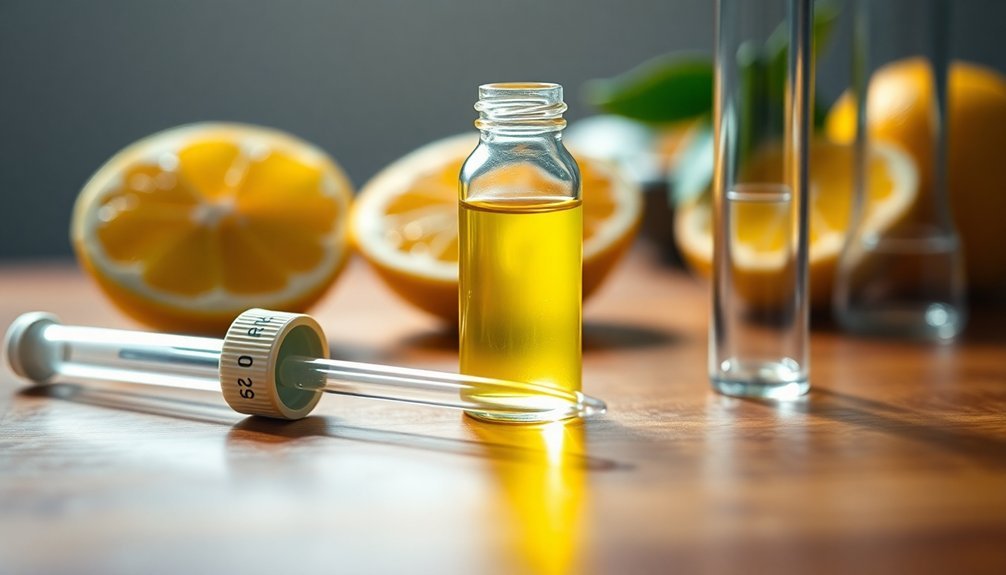
When you're creating perfumes with citrus oils, you'll need to take into account their phototoxic properties and specific dilution requirements.
Cold-pressed oils like bergamot, lime, and lemon require careful dilution – from 0.4% to 2% in carrier oils – to prevent skin reactions when exposed to sunlight.
To safely wear your citrus-based perfumes, you'll need to either stay out of the sun for 12-18 hours after application or switch to non-phototoxic alternatives like steam-distilled versions or naturally safe oils like mandarin and sweet orange.
Understanding Phototoxic Oil Risks
Safe handling of citrus oils requires careful attention to their phototoxic properties, which can cause severe skin reactions when exposed to sunlight.
When you're working with cold-pressed citrus oils like bergamot, lime, lemon, and grapefruit, you'll need to understand their potential risks and take proper precautions.
- Phototoxic reactions peak within the first hour after application and can last up to eight hours.
- Cold-pressed oils contain more phototoxic compounds than steam-distilled versions.
- Mixing multiple phototoxic oils increases your risk of adverse reactions.
- You'll need to avoid sun exposure for at least 12 hours after applying these oils.
To stay safe, always follow IFRA guidelines for maximum dilution levels – 0.7% for lime and 0.4% for bergamot.
Remember that steam-distilled alternatives are generally non-phototoxic and may be safer for your perfume formulations.
Safe Dilution By Type
Proper dilution ratios serve as your first line of defense against citrus oil phototoxicity and skin reactions.
When crafting perfumes, you'll need to carefully consider each citrus oil's specific limits. For lemon oil, don't exceed a 2% dilution to avoid phototoxic effects. This means using 12-18 drops per ounce of carrier oil.
Grapefruit oil offers more flexibility with a maximum 4% dilution rate. If you're creating facial products, keep concentrations between 0.5-1.2% regardless of the citrus oil type.
For body applications, you can safely use 1-3% dilutions. Remember that orange and mandarin oils carry lower phototoxic risks, but still require proper dilution.
Always perform a patch test and store your blends in glass or metal containers to maintain stability.
Sun Exposure Time Limits
Understanding sun exposure limits with citrus oils goes beyond simple dilution ratios.
You'll need to take into account timing and potential risks when using phototoxic citrus oils in your perfumes, especially with cold-pressed varieties. While steam-distilled oils are generally safe, cold-pressed citrus oils require careful attention to sun exposure timing.
- Wait at least 12 hours after applying cold-pressed citrus oils before exposing your skin to sunlight.
- Monitor your skin for 24 hours after UV exposure, as reactions can develop gradually.
- Limit sun exposure for up to 72 hours if you're using bergamot or lime oil, even in diluted form.
- Think about using bergaptene-free alternatives or steam-distilled versions for daytime perfumes.
To stay safe, apply your citrus perfumes to clothing instead of skin, or choose evening wear formulations when using phototoxic oils.
Citrus Blending Charts for Different Perfume Strengths

Three key perfume strengths guide the art of citrus oil blending: Eau de Toilette, Eau de Parfum, and Parfum Concentrée. Each concentration requires specific ratios of citrus oils to achieve the desired longevity and impact.
| Strength | Dilution % | Best Citrus Combinations |
|---|---|---|
| EDT | 10% | Lemon + Bergamot + Orange |
| EDP | 15-20% | Mandarin + Grapefruit + Lime |
| Parfum | 20-30% | Sweet Orange + Lemon + Grapefruit |
You'll find EDT perfect for light, daytime wear, lasting 2-3 hours, while EDP offers a balanced 4-6 hour wear time. For special occasions, choose Parfum Concentrée, which provides 6-8 hours of fragrance. You can enhance any strength by layering complementary citrus notes with woody or musky base notes, adjusting the combinations to match your preferred intensity.
Measuring and Mixing Citrus Essential Oils
Precise measurements make all the difference when creating citrus-based perfumes. You'll need to ditch the traditional drop-counting method and opt for a precise scale that measures to 0.01g. Since citrus oils have varying weights and volumes, this accuracy guarantees your formulations are consistent and safe.
- Use a 20-80% ratio for your fragrance concentrate to carrier oil
- Follow the 30-50-20 rule for top, middle, and base notes
- Keep citrus oils within IFRA guidelines (2% for lemon, 4% for grapefruit)
- Allow your blend to mature for up to two weeks
Start by arranging your oils by notes, then blend from base to top.
You'll want to mix thoroughly after adding your carrier oil, using clean droppers to prevent contamination.
Remember to document your measurements for future reference and consistency.
Carrier Oil Selection for Citrus Perfumes
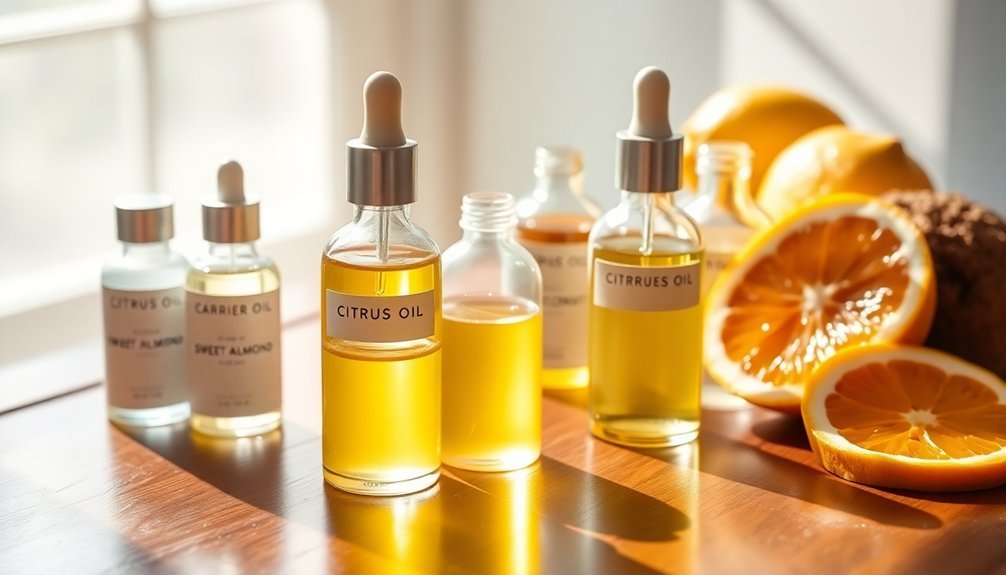
When selecting a carrier oil for your citrus perfume, you'll want to take into account its preservation properties, with jojoba oil offering exceptional stability against rancidity while fractionated coconut oil provides excellent shelf life.
The absorption rate of your chosen carrier greatly impacts how your fragrance develops on the skin, making quick-absorbing options like grapeseed oil ideal for fresh, citrus blends.
Your carrier's natural properties can enhance the overall perfume experience, as sweet almond oil's nourishing vitamins complement the skin while maintaining the integrity of your citrus notes.
Best Carrier Oil Properties
Selecting the right carrier oil serves as an essential foundation for creating successful citrus perfumes.
You'll want to take into account the absorption rate, skin compatibility, and scent profile when choosing your carrier oil. Understanding these properties guarantees your citrus perfume will perform at its best while nourishing your skin.
- Jojoba oil mimics your skin's natural oils and offers excellent stability for maintaining fragrance integrity.
- Fractionated coconut oil provides a lightweight, non-greasy base that absorbs quickly and won't compete with your citrus scents.
- Grapeseed oil's neutral profile lets citrus notes shine while delivering antioxidant benefits.
- Sweet almond oil combines gentle absorption with vitamin-rich nourishment, making it ideal for sensitive skin.
Choose oils based on your skin type – jojoba for sensitive skin, fractionated coconut for oily skin, and sweet almond for normal skin types.
Natural Preservation Benefits
Natural preservation capabilities play a key role alongside carrier oil absorption properties. When selecting carrier oils for your citrus perfumes, you'll find that jojoba and sweet almond oils offer superior antioxidant protection through their high vitamin content. These oils help prevent your perfume from oxidizing while nourishing your skin.
For ideal stability, consider fractionated coconut oil, which maintains its liquid form regardless of temperature. You'll also benefit from grapeseed oil's neutral scent and quick absorption, ensuring your citrus fragrance remains true.
Avocado and rosehip seed oils provide additional preservation benefits through their rich antioxidant profiles, while contributing subtle earthy notes that enhance your perfume's complexity. These carrier oils work synergistically with citrus essential oils, creating lasting fragrances that maintain their integrity over time.
Absorption Rate Matters
The absorption rate of carrier oils determines how effectively your citrus perfume will interact with your skin. When crafting your citrus perfume, you'll need to evaluate how quickly the carrier oil absorbs and how it matches your skin type.
- Fast-absorbing oils like fractionated coconut and grapeseed are perfect for oily skin, delivering a non-greasy finish while maintaining fragrance vibrancy.
- Moderate-absorbing oils such as jojoba and sweet almond provide balanced nourishment and gradual scent release.
- If you have sensitive skin, opt for jojoba or sweet almond oil, as they closely mimic your skin's natural oils.
- For long-lasting fragrance, choose jojoba or fractionated coconut oil, as they're highly stable and help preserve the citrus scent throughout the day.
Select your carrier oil based on these absorption characteristics to create a perfume that works harmoniously with your skin.
Creating Light Vs Strong Citrus Fragrances
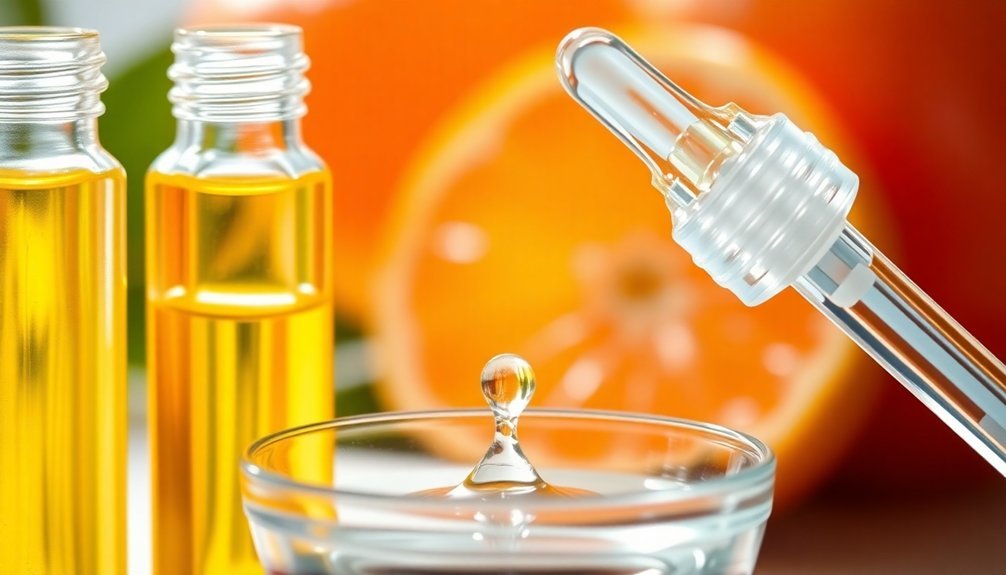
When crafting citrus fragrances, understanding the distinction between light and strong concentrations determines your final product's character and longevity. For light fragrances, you'll want to aim for a 10-20% concentration of fragrance oils, while stronger perfumes require 20-30%.
You'll find that light citrus scents typically follow a 30/50/20 ratio of top, middle, and base notes, using 18, 30, and 12 drops respectively for every 60 drops of essential oil.
For stronger fragrances, adjust to a 20/40/40 ratio, using 12, 24, and 24 drops. Remember that light fragrances need 30-40 drops of essential oil per ounce of carrier oil for a 5% dilution, while stronger ones use 60-80 drops for a 10% dilution.
Light scents last 1-4 hours, making reapplication necessary.
Seasonal Adjustments for Citrus Oil Concentrations
As seasons change, your citrus oil concentrations should adapt to match both environmental conditions and skin needs.
You'll want to adjust both your carrier oils and essential oil ratios to create seasonally appropriate fragrances that work with your skin type.
- For summer, opt for lighter concentrations with grapeseed or fractionated coconut oil, emphasizing invigorating top notes in your citrus blends.
- During winter, switch to richer carrier oils like jojoba, using lower citrus concentrations mixed with warm base notes.
- In spring and autumn, maintain balanced ratios by combining citrus oils with middle notes and moderate carrier oils.
- For sensitive skin, start with a 2-3% dilution year-round, adjusting gradually after patch testing.
Remember to take into account your skin type when selecting carrier oils – lighter ones for oily skin and richer options for dry skin.
Storage and Shelf Life of Diluted Citrus Oils
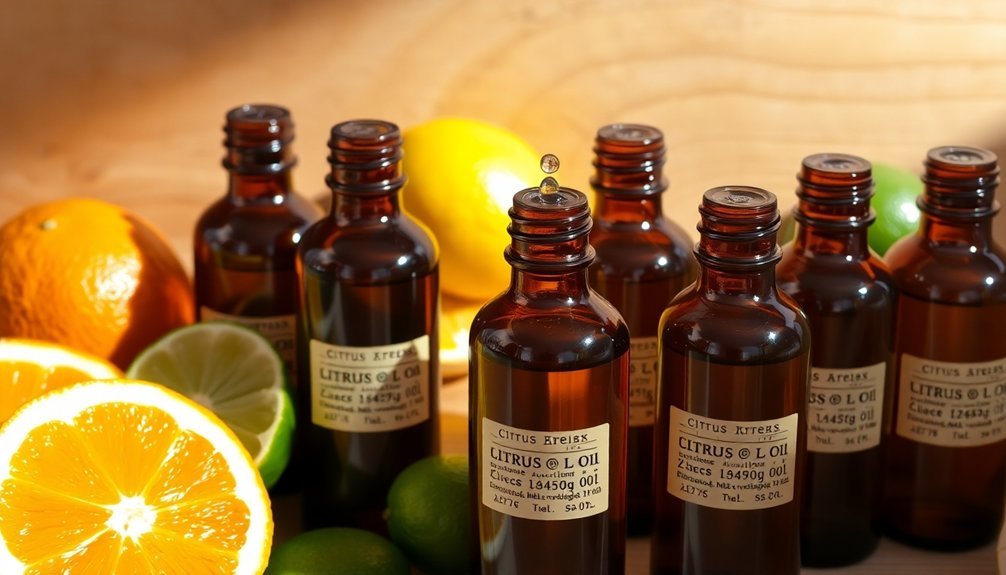
Proper storage techniques greatly impact the longevity and potency of your diluted citrus oils. When you've created your citrus oil perfume blends, store them in amber or cobalt blue glass bottles to protect against light degradation.
You'll want to keep them in a cool, dark place with temperatures between 5-30°C. Your diluted citrus oils will last 6-8 months when stored properly in the refrigerator.
Always label your bottles with both purchase and opening dates, as citrus oils oxidize faster than other essential oils. Don't forget to maintain strict hygiene – avoid touching the dropper tip and keep your hands clean when handling the oils.
If you notice any changes in smell or appearance, it's time to discard the blend. Remember to keep bottles tightly sealed to prevent oxidation and contamination.
Proper Tools for Accurate Citrus Oil Dilution
Successfully creating citrus oil dilutions requires a specific set of precision tools and equipment.
You'll need specialized measuring tools to guarantee accurate ratios when working with these volatile oils, especially since citrus oils require higher solubilizer ratios than other essential oils.
- Digital scales for precise weight measurements when mixing citrus oils with ethanol or other solvents
- Dark glass bottles with tight-sealing lids to protect your blends from light degradation
- Calibrated droppers for adding exact amounts of essential oils based on your chosen dilution ratio
- Clean mixing containers specifically designated for blending your citrus oil formulations
Remember to label your containers with the ingredients and creation date.
Since citrus oils typically need a 3:1 or higher solubilizer ratio, accuracy in measurement becomes even more critical for achieving a stable, clear final product.
Blending Multiple Citrus Oils Together
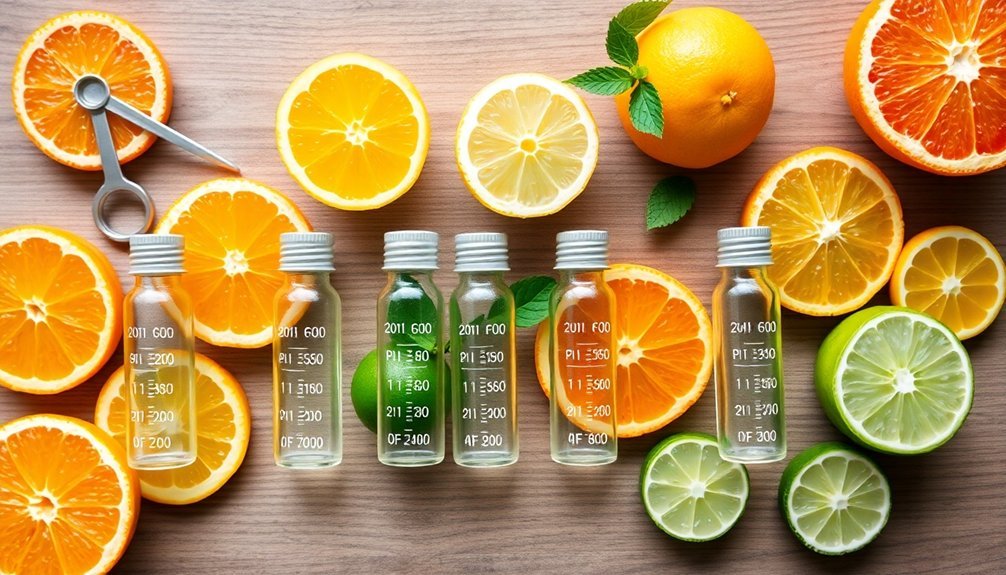
Beyond having the right tools, mastering the art of blending multiple citrus oils requires understanding their unique characteristics and interactions.
You'll want to start by selecting complementary oils like grapefruit, lemon, and bergamot, while considering their individual aroma strengths.
Begin with a base ratio of 1-2% concentration per oil, then adjust based on potency. For example, you can blend 6 drops of grapefruit with 3 drops of lemon, adding middle notes like lemongrass to extend longevity.
Layer your oils strategically, starting with heavier base notes before adding lighter citrus top notes. Don't forget to add vanilla or resins as base notes to enhance staying power.
Remember to keep total essential oil content below 2% and watch for phototoxicity, especially with bergamot and lime.
Always test your blend on a small area first.
Testing and Adjusting Your Citrus Perfume Blend
Testing a citrus perfume blend requires three key steps: evaluating the initial scent, monitoring its evolution, and making precise adjustments.
Begin by using blotter strips to test your combination, allowing each strip to dry for 10 seconds before reviewing the blend under your nose.
- Start with small amounts of citrus oils and add gradually – it's easier to add more than to correct an overpowering scent.
- Let your blend sit for at least 24 hours in a cool, dark place to allow the oils to meld properly.
- Clear your nose with coffee grounds between testing sessions to maintain accuracy.
- Record your recipe and observations to replicate successful blends.
Pay attention to how the citrus notes develop over time.
The volatile top notes will evaporate quickly, so you'll need to evaluate the middle and base notes to guarantee a balanced, long-lasting fragrance.
Frequently Asked Questions
Can I Mix Citrus Oils With Synthetic Fragrances in the Same Perfume Blend?
Yes, you can mix citrus oils with synthetic fragrances in your perfume blends. It'll actually enhance stability, extend longevity, and create more complex scent profiles while maintaining the fresh citrus character you're looking for.
How Do Environmental Factors Like Humidity Affect Citrus Oil Dilution Ratios?
You'll need to adjust your dilution ratios in high humidity as it affects oil absorption and fragrance strength. Watch for faster oxidation and consider using higher concentrations of antioxidants to maintain stability.
Do Citrus Oils From Different Regions Require Different Dilution Percentages?
You don't need different dilution percentages for citrus oils based on their region of origin. While quality and potency may vary between regions, you should still follow standard safety guidelines for dilution ratios.
Can I Use Citrus Essential Oils in Solid Perfume Formulations?
Yes, you can use citrus essential oils in solid perfumes. You'll need to blend them with carrier oils and beeswax, following proper dilution rates to avoid skin irritation and create a balanced fragrance.
What's the Difference Between Cold-Pressed and Steam-Distilled Citrus Oils for Perfumes?
You'll find cold-pressed citrus oils offer fresher, fruitier scents but can be phototoxic, while steam-distilled versions give smoother aromas and are safer for skin exposure because they're free from phototoxic compounds.
In Summary
You've now learned the essential ratios and techniques for safely diluting citrus oils in your perfume creations. Remember to start with conservative dilutions of 1-2% and adjust based on your desired strength. Keep your blends away from sunlight, use proper measuring tools, and always perform patch tests. With these guidelines in mind, you're ready to create vibrant, properly balanced citrus perfumes that'll last.
References
- https://www.immortalperfumes.com/blog/how-to-make-perfume
- https://www.newdirectionsaromatics.com/blog/blending-and-diluting-essential-oils/
- https://www.nowfoods.com/healthy-living/articles/diluting-essential-oils
- https://purensoselect.in/blogs/news/essential-oil-dilution-chart-ratio-guide
- https://ascensionkitchen.com/make-your-own-perfume-with-essential-oils/
- https://www.hearthandhomesteadstore.com/product-page/silk-road-citrus-natural-perfume-oil
- https://50-ml.com/fragrance/family/citrus
- https://www.alchemessence.com/blog/2021/03/16/a-guide-to-perfume-types
- https://credobeauty.com/collections/citrus-fragrance
- https://vetiveraromatics.com/blogs/news/4-safety-tips-for-making-perfume-with-essential-oils

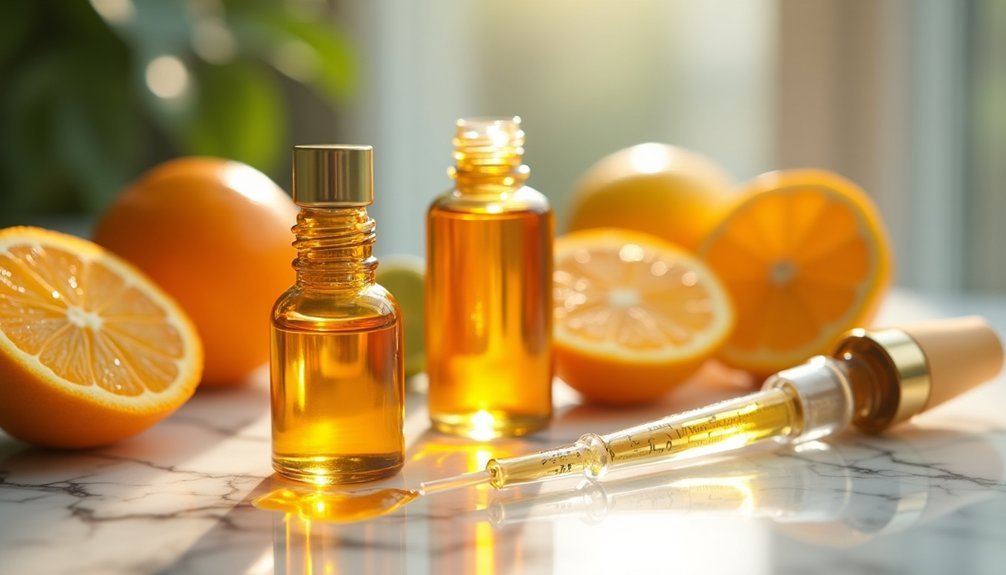



Leave a Reply